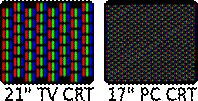Display screens

| 
| 
|
The screen of a computer is often known as the monitor or display, or VDU (visual display unit). It is a piece of electrical equipment which displays images generated from the video output of computers, without producing a permanent record. The monitor comprises the display device, simple circuitry to generate and format a picture from video sent by the signals source, and usually an enclosure. The monitor is controlled by a separate circuit board, known as the display adaptor, which plugs into the motherboard of the computer and generates video in a format compatible with the monitor. The video card processes images and sends signals to the monitor. For example, the VGA (video graphics array)card has become a standard for colour monitors.
Older monitors are based around a cathode ray tube (CRT),similar to a traditional TV set. At the
| back of the tube there is a negatively charged cathode and three electron guns - each gun shoots out a beam of electrons for each of the primary colours: red, green and blue. These electrons strike the inside of the charged screen which is coated with substances called phosphors(there are different materials for each of the three colours) that glow when struck by electrons and create colours. | 
|
Each cluster of three phosphor dots, one of each color, is one pixel. The electron beam scans the screen and turns on or off the pixels that make up the image. To create different colours, the intensity of each of the three electron beams is varied. There are two electromagnets around the collar of the tube which deflect the electron beam. The beam scans across the top of the monitor from left to right, is then blanked and moved back to the left-hand side slightly below the previous trace (on the next scan line), scans across the second line and so on until the bottom right of the screen is reached. It is again blanked, and moved back to the top left to start again. It scans the screen in a continuous sequence, similar to the movement of our eyes when we read, but much faster - this process draws a complete picture. This sequence is repeated 50-100 times per second,

| depending on the system. If the rate of this repetition is low, we can perceive a flickering, unsteady screen, which can cause eye fatigue. CRTs are cheap, but they are heavy, can flicker and emit radiation. |
Most newer monitors typically consist of a TFT-LCD. A Liquid Crystal Display (LCD) is made from flat plates with a liquid crystal solution between them. The crystals block the light in different quantities to create the image. Active-matrix LCDs use TFT (thin film transistor) technology, in
| which each pixel has its own transistor switch. TFT systems offer a wider angle of vision and high-quality images, they are flat and take up less space, use less power than CRTs, they are distortion-free while typical CRTs are curved, which may cause image distortion, so they are replacing CRTs. Users talk of benefits such as more desk space, how easy they are to adjust for tilt | 
|
and height, crisper, clearer images and the total elimination of screen flicker. Manufacturers offer compatible flat screens including built-in stereo speakers, headphone connection, and a USB port. Some models can also be removed from the stand and mounted on the wall. They come with stylish designs for a variety of applications.
Plasma displays have many advantages: high-contrast images and bright colours, generated by a plasma discharge which contains noble, non-harmful gases. Gas-plasma TVs allow for larger screens and wide viewing angles, perfect for movies.
Home cinema enthusiasts set up systems with a DVD recorder, speakers for surround sound, and a rear projection TV, which has the video projector and the screen within a large TV box. It’s a real cinema experience.
Video projectors are used when audiovisual presentations are on a laptop connected to a front-screen projector which displays the images on a distant screen or white wall.
Portable DLP projectors are used for business presentations. This is a digital light-processing device which creates the image with millions of microscopic mirrors arranged on a silicon chip.
Дата добавления: 2015-07-30; просмотров: 1728;
